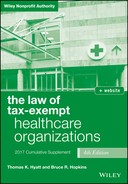CHAPTER TWENTY‐FIVE
Physician Recruitment and Retention
§ 25.5 SPECIFIC RECRUITMENT AND RETENTION TECHNIQUES
(b) Income Guarantees
p. 667. Insert following the first full paragraph:
A common hospital practice has been to treat forgiven amounts (including interest) as taxable income for the physician only when the amounts are forgiven (e.g., monthly or annually), with the treatment of the remaining income guarantee balance as a loan. Since the physician could leave the hospital service area during the term of the agreement and thereby trigger a full repayment provision, which is consistent with characterization of the guarantee as a loan rather than as current income, it is reasonable to report income to the physician only upon forgiveness of guaranteed amounts.
However, in 2013, a federal district court upheld an IRS ruling position that in cases where an employer provides a loan with no real expectation of repayment (other than through the provision of services) or of treatment of the payment as a loan, then the payments are instead an advance of wages and appropriate withholding and payment of taxes must occur.34.1 In this case, the Vancouver Clinic, which was organized as a professional services corporation, entered into “associate physician loan agreements” with newly hired physicians. The purpose of the agreements was to enhance physician recruitment and retention by the clinic. Under the agreements, the physicians would work for the clinic for a period of five years, in exchange for an advance of funds during the first two years of their employment. The physicians were required to repay the advances only if they ceased their employment with the clinic during the first five years. Advances under the agreements accrued interest at the prime rate. However, the physicians were not required to pay the accrued interest during the term of the agreements if they continued to be employed by the clinic. The clinic intended to retain the physicians as employees for their full five‐year terms, and the physicians likewise shared that intent.
The clinic did not withhold payroll tax on the advances, or report them as wages at the time of their forgiveness. The IRS subsequently assessed withholding and FICA taxes plus interest on the amounts advanced. The clinic paid the assessments and filed a claim for a refund.
The federal court in its decision noted that there is one principle for determining whether a transaction is a loan for tax purposes, which is that there must be an unconditional promise to repay advanced funds at the time the agreement is entered into. Thus, whether the parties actually intend for advances of funds to be repaid at the time the arrangement is entered into is critical; in the court's view, the transaction is not a loan if the parties do not intend repayment when they enter into the loan agreement.
In this case, the court found that the parties expected at the time of entering into the agreement that the physicians would remain employed for at least five years and therefore would not have to repay their loans. The parties' expectation and intent was that the loans would be forgiven.
Accordingly, the court was compelled to conclude that the advances under the loan agreements were actually compensation for services. They were wages, required to be recognized as compensation, and the clinic was obligated to withhold appropriate employment and income taxes from the advances and report them to the physicians on a Form W‐2 in the tax period in which the payments were made.
This position taken by this court has not been uniformly adopted; a different result was reached in a 2002 Tax Court memorandum decision that was not cited in the Vancouver Clinic opinion.34.2 Nevertheless, the risk of an unintended taxation event for a physician receiving a forgivable income guarantee can be mitigated by structuring the forgivable guarantee as a traditional loan with a secured promissory note to secure the debt, and providing a bonus to the physician to provide a source of funds for repayment.34.3
